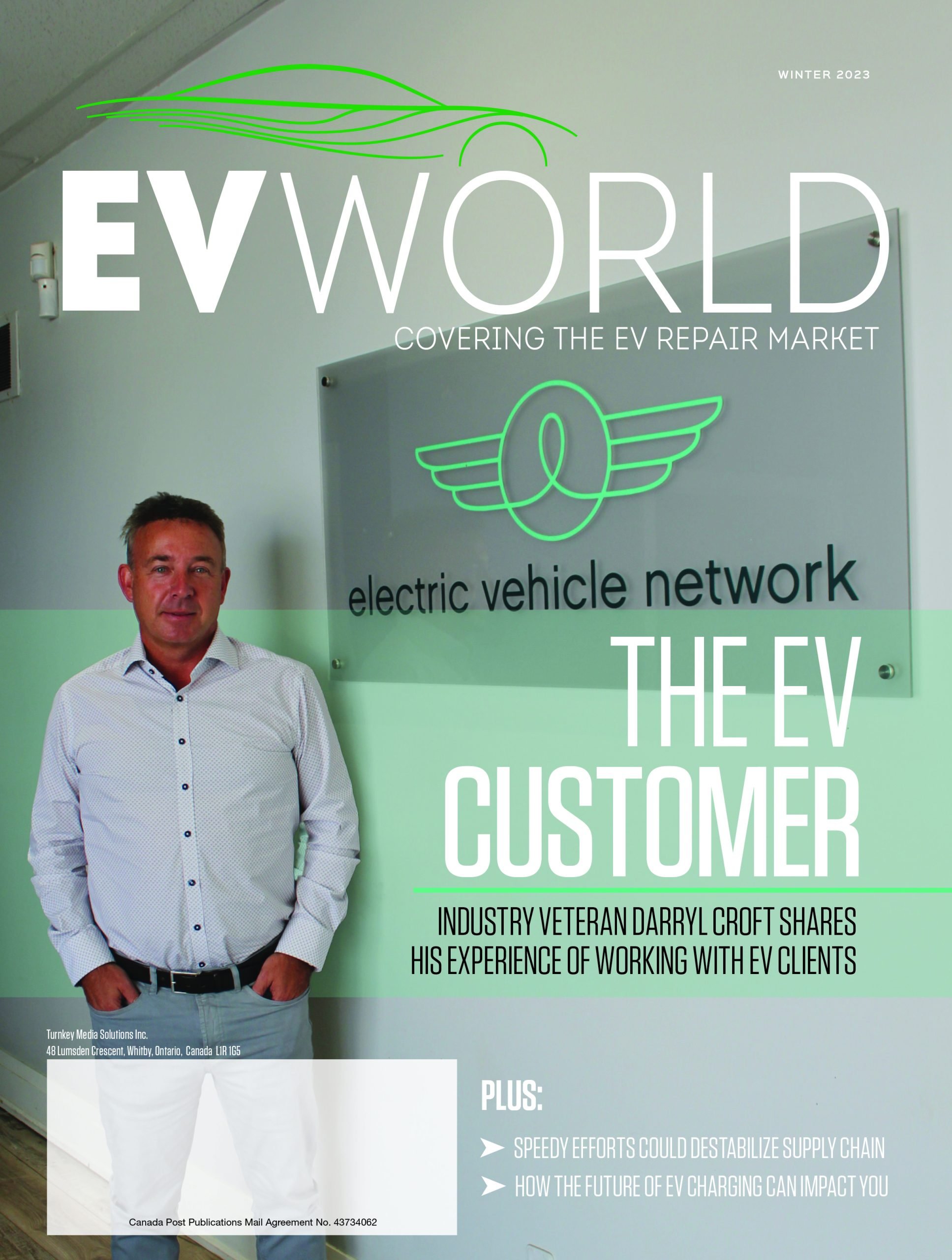
EV World: Today’s EV customers
Older shoppers make up most electric vehicle customers. Industry veteran Darryl Croft shares his experiences of working with EV customers, how his company helps buyers find the right fit and what the aftermarket needs to do
 Darryl Croft is no stranger to the auto care industry. He’s probably been best known as the co-owner and vice president of an OK Tire shop in the west end of Toronto. He’s a director of the Automotive Aftermarket Retailers of Ontario, an association for independent automotive service professionals. So he’s a well-seasoned industry professional.
Darryl Croft is no stranger to the auto care industry. He’s probably been best known as the co-owner and vice president of an OK Tire shop in the west end of Toronto. He’s a director of the Automotive Aftermarket Retailers of Ontario, an association for independent automotive service professionals. So he’s a well-seasoned industry professional.
A few years ago, he realized something. He was fielding a lot of questions from customers and pros alike about electric vehicles. But it was difficult to get the answers. There weren’t enough experts going around. At least, those who were unbiased. And it was next to impossible to get the real-life experience of working on or riding in an electric vehicle.
So the Electric Vehicle Network was born. Croft is the president. His company specifically serves to educate consumers about EVs. The business, just down the street from his OK Tire location, services EVs. It allows curious consumers to test out the vehicles. They can learn the ins and outs of an EV — even how to plug it in to charge up. And they can even buy an EV from him — the network can source a vehicle of the customer’s liking.
Croft and Mavreen Brooks, an EV consultant at the Electric Vehicle Network, sat down with EV World to talk about what they’re seeing in the EV market, how it’s evolving and what impact it will have on the aftermarket.
EVW: What types of people typically come through your doors?
DC: Definitely the predominant requests we get are from older adults who are looking at an electric vehicle. We haven’t specifically dug into each individual shopper as to why the older demographic is looking at electric. But the line is, they’re done with gas. So I don’t know if they’ve been driving long enough and realize the overall cost and headache that comes with an internal combustion engine — the maintenance, the breakdowns, the unpredictability — I don’t know if it’s that, but they certainly get to that point where they want to drive clean. And, actually, some shoppers have been very specific that they want to do something right and stop polluting more.
The cost of vehicles today becomes a factor. So it could be partially affordability — older adults may be in a better position to actually make that decision and afford an EV. There’s always been a premium to go electric.
EVW: What do you hear from younger folks? What do they say about EVs?
DC: I must say: On the opposite side, when I speak to younger adults who I thought would be totally into an EV — because no oil changes, less visits to the shop, no gas station — but they’re the ones who seem to be saying, “Oh, I don’t want that monthly payment that high.” Or, “I go on camping trips and I don’t want to worry about charging.”
Where they live, they may not have charging — that’s another one I hear. That’s a big thing, actually. Older people are settled where they’re staying. Younger people may be on the move; they’re not sure where they’re going to be. I’ve had even adults that own electric vehicles and, given the uncertainty of where their kids are going to be living, they actually tell their kids, “Don’t get electric until you’re stable and you know where you’ll be living.”
It’s very interesting to see the interest level amongst demographic groups.
Whereas older adults, probably their kids are gone. They have less demand for big space. And it’s easier from that point of view as well to get into an EV.
EVW: Isn’t it an option problem as well? The types of EVs available are limited.
MB: With the younger people, they’re starting families and the size of EVs don’t reflect what they need. So yes, there’s the Bolts, the Leafs and the Tesla Model 3s — that’s what would be affordable to them. But at the same time, they want larger vehicles because they do have the car seats, the strollers and whatnots and all of that.
DC: There are some big electric SUVs coming out now but they’re at a high price tag. Outside of the range, that’s another thing to worry about as a young family. Whereas older adults, probably their kids are gone. They have less demand for big space. And it’s easier from that point of view as well to get into an EV.
EVW: Don’t EVs have a lot of space to meet these demands?
DC: In reality, a lot of people don’t realize small EVs have big storage space. There’s no engine, there’s no transmission. A big part of what we do is helping people experience an EV. We get the comment, “Wow, I didn’t realize how spacious this car was. I can fold down the seats. I can fit a lot in my car.”
For a two or three-car family, do you need two big SUVs? Not really, in a lot of cases. You can save yourself a lot of money having a more of a zip-around car. And if you need one big honker to go on long road trips, so be it.
EVW: What are the biggest concerns people have when they ask about an EV?
DC: Absolutely, range anxiety is a real deal when anybody’s shopping for an EV. So I would think that would be one factor, and unpredictability of where to charge. And I’m going to say patience, a little bit. And that’s why EVs fit better for older people.
In moving to electric, definitely interest is there. But going through the thought process of actually getting to the end part is where a lot of people stumble in terms of one of these obstacles.
EVW: What’s the most common question you’re asked by someone curious about an EV?
MB: “How much range?” Because they’re under the assumption that they need a massive amount of range. They’ll come in thinking that they need a vehicle with 500-plus kilometres worth of range. Although they may drive 34 kilometres one way to work on the higher end of things. Once they realize that they don’t necessarily need 500 kilometres — and if they are going a far distance, they realize they can stop along the way, take a rest, charge of the vehicle and whatnot — then their thinking changes.
After speaking with us, doing test drives, showing them economical ways to drive the vehicle to get the most battery usage out of it, they realize that they don’t necessarily need to commit to a vehicle that has 400 kilometres of range, maybe something around 250 kilometres will be better suited.
DC: I hear questions around, “How long will the battery last?” When, really, time and time again, it’s proven that these batteries by and large are outlasting the body of the car. And so they’re still stuck on the idea, “Oh, how much is the cost if the battery fails?”
The battery is warrantied for eight years, 160,000. All the studies are showing, by a wide margin, these batteries are way outlasting the predictions, even of the manufacturers. The manufacturers do not want to have people replacing batteries in their cars.
So when customers find that out, it’s a big shocker to them. It’s an unfounded fear. That’s not to say a battery issue doesn’t happen. But the manufacturers support their vehicles.
It’s having that real discussion with them about how much range do they actually need. Do you actually need the all-wheel drive? Do you live within the city?
EVW: What is a key question you ask shoppers to make sure they’re able to take on an EV?
DC: We make sure they think about charging. We ask them, “Where do you live? Can you have a charger where you live or where you work?” That’s very important. And then we ask where they normally travel. We make them aware of the public charging network that’s out there. So we direct them to resources and say, “Look, you got a charging place right next to where you live, just in case you can’t put one in.”
It also gets down to the monthly payment. So people will say they have a budget of $X per month. But they don’t realize that the average driver will save about $500 a month compared to a gas vehicle with gas and maintenance. Adding that to the equation makes it much, much more affordable.
MB: It’s having that real discussion with them about how much range do they actually need. Do you actually need the all-wheel drive? Do you live within the city? Do you actually make commutes out of the city where you’re going through deep snow and need the all-wheel drive? So it’s just bringing them back to reality in terms of what they actually need. And at that point in time, we’re able to let them know of other models that may suit them better.
EVW: How will more EV model options change people’s perceptions?
DC: I do believe as new models come out, and they’re lower priced, the used market, by default, has to become more affordable. And that opens up accessibility to more people on the used side. I don’t hold a lot of hope that the new vehicles coming out are going to be cheap anytime soon. Everyone has said they’d offer it, but in practice, we haven’t seen it happen. The affordable models have not hit the street yet, even though there have been pledges that they’re going to try and compete in that space.
What the world needs is affordable EVs, whether it be used or better selection. So I think I think used is going to be the Number 1 path to affordability for the foreseeable future.
EVW: Is it becoming less convenient to have a gas-powered vehicle?
DC: It’s interesting. If you look at Toronto, in reality, getting gas is not easy. The gas stations are disappearing at a rapid rate in urban centers — and charging is exploding. Charging availability is much more available. But it’s almost like you don’t know what you don’t know. So when you think that, “Oh, I want to be sure my kid can get gas if they need it without getting stuck.” And they don’t realize that if they really understood the charging network, more often than not that’d see they could charge publicly — and it’s only going to get better than what it is today.
And believe me, they’re worried about the first time plugging in the vehicle — they don’t know how to do it. They don’t realize it’s really simple. But until they physically do it themselves, they’re scared.
EVW: So how do you bridge the knowledge gap and help people understand the reality of EVs?
DC: Our point of view on that is experience and education in a real EV. You can read about it all you want, you can listen to all about it but until you actually drive it, take it for the weekend, go to Montreal or go to Ottawa, realize that it’s not a big deal to charge — and it’s not expensive. A lot of people think it’s a ton of money to charge. It’s not. And believe me, they’re worried about the first time plugging in the vehicle — they don’t know how to do it. They don’t realize it’s really simple. But until they physically do it themselves, they’re scared.
EVW: How should the aftermarket be preparing to service EVs?
DC: The most annoying thing that EV owners face is when they go to the aftermarket for service and the aftermarket doesn’t know anything about the technology, their product — they’re ignorant. And that really ticks off a car owner. They say, “I’m not going to go get service to a place that doesn’t know anything about my product or what I’m doing.” So the education about EVs is very important.
In the automotive world, you have to understand your client. And if you don’t want to, that’s great. Don’t do it. But if you’re going to do it, do it right. And it is definitely going to be a growing part of the market over a period of time. And do it right. So it means investing in your training your people, gaining your knowledge, your experience.
EVW: What has support looked like from the supplier end of the aftermarket? How are they helping?
DC: I must say the suppliers are starting to do a much better job of bringing training to the shops, whether it be the NAPAs of the world or the WorldPacs of the world. I can tell you, in the back end, there’s a lot of effort going on to train our technicians in the industry. The government’s got involved with a lot of training support. So it takes the will of those shops and technicians to participate in that.
This article originally appeared in the Winter 2023 issue of EV World
.png)








Have your say: